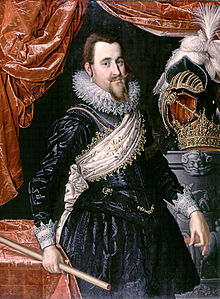Danish East India Company
The Danish East India Company (Danish Ostindisk Kompagni ) was a trading company that owned the Danish export and import monopoly for India ( India trade ) and East Asia (especially with the Spice Islands and the Empire of China ). The First Danish East India Company existed from 1616 to 1650. After a 20-year hiatus, the Second Danish East India Company existed from 1670 to 1729.
First East India Company (1616–1650)

The Danish East India Company received the royal trade privilege from Christian IV in 1616. However, the start of business was delayed because there were initially difficulties in raising sufficient capital. Not until 1618 was a sufficient sum of 178,999 thalers raised. The shares were distributed among the crown (12.5%), the nobility (15.5%), Copenhagen citizens (35%), bonds from the various provinces (29.5%) and Dutch and Hamburg merchants (together 7 , 5%).
The main base of the East India Company was in the town of Tranquebar in Fort Dansborg, which was built in 1620 by Ove Gedde . A contract between the local ruler and the King of Denmark sealed that the new settlement was officially Danish property and that the governor was a representative of the Danish crown. By 1639, the company had sent 14 ships to Asia, which transported not only commercial goods but also Danish settlers, before contact came to a standstill due to high ship losses and, not least, the Thirty Years' War . After the death of Christian IV in 1648 the trade broke off completely and the company was dissolved in 1650. Tranquebar, however, remained a Danish outpost.
Second East India Company (1670–1729)
In 1668 a state and privately financed supply ship was sent to India, which returned to Denmark unscathed with goods. The successful trip sparked new interest in closer trade relations with Asia, so that the second East India Company was founded in 1670. From 1670 one or two ships sailed to Asia every year. I.a. Continuous attacks by the Swedes on the ships caused financial difficulties and made a capital increase of 12% necessary in 1681. Nevertheless, the financial situation remained tense. The company was dissolved in 1729 due to insolvency and Tranquebar reverted to the Crown.
Danish Asia Company (1732–1843)
Despite the setbacks, interest in trade with Asia continued unabated. So in 1732 a third attempt was made with the now Asia Company (Danish: Asiatisk Kompagni ). It lost its trade monopoly for India in 1772, as many shareholders had withdrawn their capital in order to conduct free trade on their own responsibility ; however, the monopoly on trade with China remained. The neutrality of Denmark in particular was helpful, because different nations could use the Danish trading points in times of war, which initially secured the Danish presence.
During the Napoleonic Wars , Denmark fought on the French side . As a result, the British Royal Navy attacked the branches of the Danish company in 1801 and 1808, which brought trade to a standstill. Even the Congress of Vienna in 1814 was unable to completely restore the previous structures. Business developed poorly, so that the Asia Company was dissolved in 1843. The Danish governor had to vacate Tranquebar in 1845 after the trading seat was sold to the British East India Company .
Tea trade
During its heyday, the Danish and Swedish East India Companies imported more tea than the British East India Company , but 90% of it was smuggled into Great Britain at great profit .
See also
literature
- Stephan Diller: The Danes in India, Southeast Asia and China (1620-1845) (= South China and maritime Asia. 8). Harrassowitz, Wiesbaden 1999, ISBN 3-447-04123-4 (also: Bamberg, Universität, Dissertation, 1997).
- Jürgen G. Nagel : The adventure of long-distance trading. The East India Companies. Scientific Book Society, Darmstadt 2007, ISBN 978-3-534-18527-6 .
